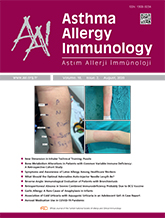


Physical urticaria is a heterogeneous group of inducible conditions in which symptoms are induced by exogenous physical triggers such as cold, water, heat, and mechanical stimuli, acting on the skin. Our case involves a sixteen-year-old female patient who presented with erythema, small wheals and pruritus on her skin after contact with water and cold. After conducting water and ice cube provocation tests in addition to her medical history and physical examination, the patient was diagnosed with aquagenic urticaria (AU) and cold urticaria (CU). Her complaints had started 20 days before presentation. Regardless of the temperature and the source of water, her symptoms increased after contact with water, and the physical examination disclosed thoracic scoliosis. Symptoms were significantly relieved after one month of antihistamine and liquid petrolatum treatment. However, the patient developed complaints of urticaria, itching and angioedema in the contact areas of the body after contact with cold air, cold water, and cold objects in the winter season. She was tested with ice cubes and the result was positive. We started treatment with omalizumab, and her symptoms improved at the eighth week of this treatment. Here we present an adolescent female patient diagnosed with CU and AU.